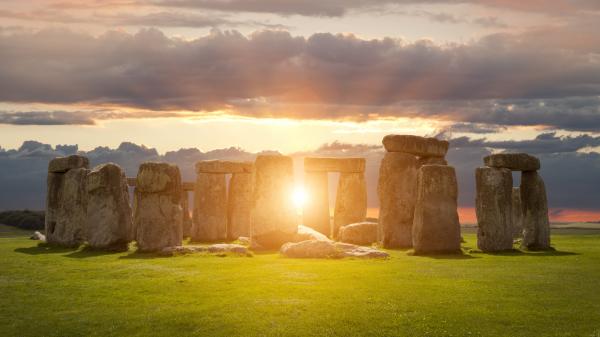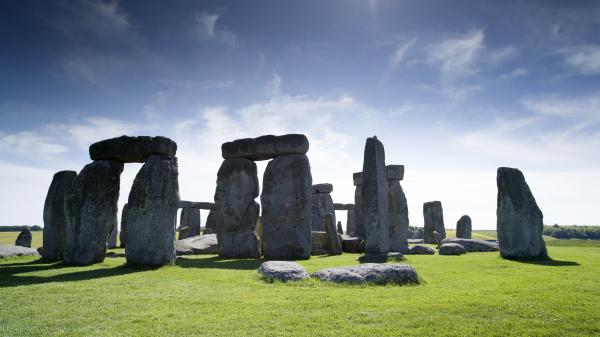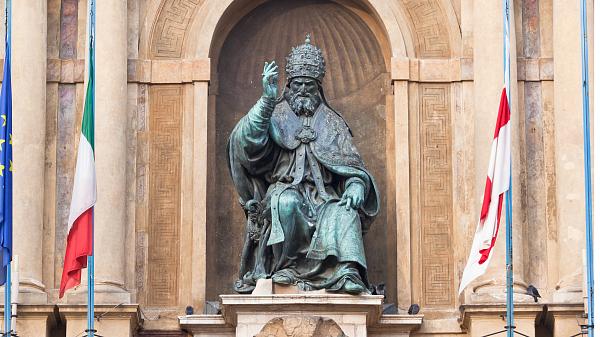What Is a Calendar?
Different types of calendars have existed for thousands of years. Where do they come from, which types exist today, and why were calendars invented in the first place?

Stonehenge in Great Britain is one of the oldest surviving calendars humans used to mark and measure time.
©iStockphoto.com/AndyRoland
A calendar is a system for recording and organizing time by counting days and months during the year. With calendars, it is possible to determine the precise beginning and end of seasons, and to plan common future events.
Calendar Meaning
The word calendar comes from the Latin kalendae meaning “first day of the month.” In ancient Rome, the first day of every month was publicly called out (calare in Latin) as a sign for people to settle their debts. Payments and debts were recorded in the accounting books called calendaria.
Throughout history, people have developed different calendars—some based on the movements of the Sun and Moon, and others based on numerical systems. Today, we mainly use three types of calendars: Solar, lunar, and lunisolar.
Solar Calendar – Our Main Calendar
The solar calendar is one of the oldest known tools of timekeeping, and it is still used in many parts of the world today. A solar calendar is based on the revolution of the Earth around the Sun.
One complete revolution around the Sun is called a year. The solar year is divided into 12 months or 365 days, with an extra leap day to be added in some years. The most widely used solar calendar is the Gregorian calendar.

The Heel Stone of Stonehenge is arranged to “catch” the Sun exactly at the solstice in June.
©bigstockphoto.com/dubassy
It’s Actually Two Calendars: Tropical and Sidereal Calendar
There are two different versions of solar calendars: The tropical solar calendar and the sidereal solar calendar. Both focus on Earth’s revolution around the Sun but measure the revolution differently— while the tropical calendar uses seasons, the sidereal calendar uses fixed stars.
Tropical Calendar: Our Modern Standard
A tropical solar calendar—such as the Gregorian calendar—is based on the Earth’s position in its orbit around the Sun and the effects of this position on the length of a day on Earth. A year in the tropical calendar lasts from one solstice to the next or from one equinox to the next.
What does the solstice have to do with our calendar? The short answer is that it was a good way to mark a special date in time. The solstice can be spotted even without any astronomical tools—and it can be used as a marker to measure exactly one year.
Make Your Own Calendar – Spotting the Solstice
“If you choose a good place to observe, you can spot the solstice yourself”, says astronomer and popular science blogger Dr. Philip Plait. “It’s not easy, but with careful planning and observation, you can do it.”
If you observe the Sun setting every day, you will see that it doesn’t set in the same spot every evening. Every sunset, the Sun appears to have “moved” a little on the horizon.
“It’s a good idea to choose a distinct geographical landmark, such as a distant mountain range, to give you a reference point,” recommends Dr. Plait. “It is important to select your observation point carefully and to stand in the exact same spot every time. Even then, it is hard.”
Where does the Sun rise in your location?
Around June 21, the Sun stops moving along the horizon: It will set in the same spot for a day and then move back in the other direction the next day.
This turning point is called solstice, from the Latin solstitium (“stopping of the Sun”). The ancient Greeks named the spot where the Sun turns around the tropikos; this is why the tropical calendar traditionally starts and ends with the summer solstice.
Try it yourself and see where the Sun rises in your location:
Go to our Interactive Night Sky Map and look for the Sun. Click on the sunrise time, and the Night Sky Map will show you the exact direction of your sunrise.

Even modern architecture sometimes aligns with the solstice. Pictured here are the streets of Manhattan as they catch the setting Sun creating the “Manhattanhenge” effect.
©iStockphoto.com/Elisank79
Sidereal Calendar: An Astronomer’s Calendar
A sidereal solar calendar ignores solstices and equinoxes and traditionally measures the Earth’s orbit around the Sun by observing the Sun as it travels through the twelve zodiac signs in the night sky. The name sidereal comes from the Latin sideris (“of the star”).
Follow stars and constellations in our Night Sky Viewer
While the tropical calendar focuses on the Earth and its seasons, the sidereal calendar focuses on the stars and the Sun. Because the sidereal calendar requires watching the sky and the movements of planets and stars, it’s associated with astronomy.
Lunar Calendar – Imperfect But Important
The lunar calendar measures the cycles of the Moon’s phases. Each month in a lunar calendar begins on the New Moon and ends on the next New Moon. A lunar month or lunation takes about 29.53 days, slightly less than a month in the solar calendar (30 or 31 days). The lunar calendar is divided into 12 or 13 months, depending on the culture that is using it.
The Moon’s orbit around the Earth is elliptical, and the length of the lunar month changes every month. These factors, combined with the varying number of days in a calendar month, make it practically impossible to create a reliable calendar for civil use—such as agriculture—that spans several centuries using only the Moon.
Despite their low resolution, lunar calendars have been used widely throughout human history and are still in use today. Why is that? There is an important part of society that does not need high accuracy but instead needs to relate to everyday experiences and natural cycles: Religion.

The Islamic month of Ramadan begins as soon as the new crescent Moon has been sighted.
© iStockphoto.com/damircudic
Religious events and festivals almost always go back to lunar cycles; that is why many cultures around the world still use lunar calendars to find the date for important religious holidays such as Easter, Rosh Hashanah, Ramadan, the Chinese New Year, and Diwali.
Lunisolar Calendar – Better Than Lunar, But No Solar
A lunisolar calendar is based on the movements of both the Moon (luni) and the Sun (solar). A year in the lunisolar calendar has twelve months, each either 29 or 30 days long, determined by the phases of the Moon. The length of the year is based on the Sun, similar to the solar calendar.
To keep the solar and lunar astronomical cycles in sync, a lunisolar calendar adds extra days or months to the calendar. This is called intercalation; an intercalary month is usually added at the end of some years (leap years).
Because a lunar month is shorter than a solar month, 12 months don’t equal 365 days. The ancient Roman calendar, for example, counted only 355 days per year, 10 days less than the solar year. The Romans had to add an extra month called Intercalaris (meaning “between the calendars”) at the end of the year to get the number of days to 365.
Lunisolar calendars are still used around the world, mainly by cultures that use their calendar to mark religious events and festivities. Examples of lunisolar calendars include the Chinese calendar and the Jewish calendar.
Three Popular Calendars in Use Today

The Gregorian calendar, named after Pope Gregory XIII, is the most used calendar today.
©iStockphoto.com/vvoevale
Gregorian Calendar
The most commonly used calendar today is the Gregorian calendar, a solar calendar. Originally the official Christian calendar, today’s Gregorian calendar is a civil calendar: It is used for non-religious administration around the world.
As of 2021, the Gregorian calendar has been adopted by 168 countries as their official calendar. Only four countries have not adopted the Gregorian calendar: Afghanistan, Iran, Ethiopia, and Nepal.
Current year: 2024 CE.
Islamic Calendar
The Islamic calendar or Hijri calendar is a lunar calendar consisting of 12 lunar months and 345 or 355 days. The Hijri calendar is used to determine dates for Islamic holidays and rituals like Eid al Bakr and Ramadan.
Almost all Islamic countries (countries with Islam as the predominant religion) use the Hijri calendar for religious purposes and the Gregorian calendar for civil planning. Notable exceptions are Iran and Afghanistan, which use their own civil calendar.
Current year: 1445 AH.
Chinese Calendar
The Chinese calendar is a lunisolar calendar with 12 months in a common year (about 354 days) and 13 months in a leap year (about 384 days). The Chinese calendar is still used in China and many Chinese communities around the world to determine religious and traditional holidays like the Lunar New Year. For civil purposes, China uses the Gregorian calendar.
The Chinese calendar does not count infinite years like the Gregorian, Jewish, and Islamic calendars but counts in a 60-year cycle. Every year has a name consisting of a type of element (like gui or “standing water”) and a zodiac animal (like mao or “rabbit”).
Current year: The Gregorian year 2023 (after January 22, 2023) is Gui Mao in the Chinese calendar, the year of Standing Water Rabbit.
Why Did Humans Invent Calendars?

Understanding and predicting seasons of extreme weather could have been the reason why humans invented calendars.
© iStock.com/Revolu7ion93
Calendars are a way to keep track of the past and to plan for the future. Modern calendars help us plan our lives individually and as a society, remind us of important celebrations and rituals, and generally give us a sense of time.
But why did humans come up with calendars in the first place?
There is no simple answer to that question. Many historians, archeologists, and philosophers have thought about it—here are some of the possible reasons why humans invented the calendar:
- Farming: As soon as humans settled down and became farmers, they needed to plan their crops and their harvest. A calendar that tells you precisely when seasons start and end, helps you to optimize your crops and the yield of your fields.
- Religion: To celebrate religious rituals and festivals with some regularity, you need fixed points in time. One way was to follow natural cycles like the Moon’s phases or the annual flooding of a river delta.
- Power: Whoever understands and can predict a coming flood, monsoon, or the place where Sirius appears in the night sky, gains power in their society. It looks as though that person controls nature—as a sage, a shaman, or, more directly, as a chieftain or a tribe leader.
Astronomy and Calendars Go Hand in Hand
Before humans could record time and plan for the future with calendars, they needed to know how to read the stars. Astronomy and calendars—which came first? Astronomer and science educator Dr. Philip Plait makes the case for a simultaneous development:
“Our brains have evolved to notice patterns; if you live in a place where the skies are dark and stars obvious, you'll notice pretty quickly that certain constellations are up after sunset—for example when the seasons change”, says Dr. Plait.
“In the Northern Hemisphere, Orion is high in the southwest when spring arrives; both rather noticeable events! It’s natural then to start marking days when these patterns are seen, and after a while, it would be hard to miss that the patterns repeat every 365 days. So I would guess the advent of calendars and paying attention to the skies went hand in hand.”